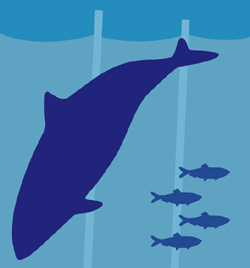Harbour
Porpoises:
Threatened
in the Bay of Fundy.
Distribution
and Habitat
Harbour
porpoises generally live in coastal waters less than 150 meters deep, and
their common name is derived from their regular appearance in bays and
harbours. Sometimes people refer to porpoises as puffing pigs, probably
because of their robust bodies and the puffing noise they make when they
surface and breathe.
Natural
History
Harbour
porpoises are generally shy animals, and tend to avoid boats underway.
If you do encounter one in the wild, you'll likely only catch a quick glimpse
of their back and small, triangular dorsal fin - like the picture above!
They are one of the world's smallest cetaceans, growing to an average length
of 1.55 m and a mass of 55 kilograms. Female porpoises are usually larger
than males. It is believed that porpoises can live as long as 20 years.
Harbour porpoises become sexually mature between 3 and 5 years of age.
After that time, female porpoises usually produce one calf every year.
Porpoises feed on primarily on herring (Clupea harengus), and also
eat capelin (Mallotus villosus) and gadoid fishes such as pollack
(Pollachius virens) and hake (Merluccius bilinearis). Porpoises
also eat squid. Recently weaned porpoises eat euphausiid shrimp. Harbour
porpoises are deep divers, capable of reaching depths in excess of 200
meters.
Status
and Protection
Many
harbour porpoise populations around the world have been depleted through
bycatch in fisheries and the Bay of Fundy/Gulf of Maine stock is not exception.
In Atlantic Canada, harbour porpoises are listed as threatened by
the Committee on the Status of Endangered Wildlife in Canada (COSEWIC).
As well, Northwest Atlantic harbour porpoises are currently designated
as a strategic stock under the U.S. Marine Mammal Protection Act
(MMPA) because bycatch levels remain high for this population. Harbour
porpoises are listed in the IUCN Red List of Threatened Species as vulnerable
throughout their range.
Threats
to the Species
Porpoise
populations throughout their range continue to be threatened by incidental
mortality in many fisheries. Hundreds of porpoise are killed in North American
fisheries yearly. Chemical and noise pollution may also threaten this species.
Important
Links:
Harbour
Porpoise Release Program
 Begun
in 1991, the Harbour Porpoise Release Program was developed by the Grand
Manan Whale & Seabird Research Station to assist herring weir operators
safely remove harbour porpoises from their weir without loosing the trapped
herring. Begun
in 1991, the Harbour Porpoise Release Program was developed by the Grand
Manan Whale & Seabird Research Station to assist herring weir operators
safely remove harbour porpoises from their weir without loosing the trapped
herring.
Go
to the Harbour Porpoise Release Program |

![]()

![]()

